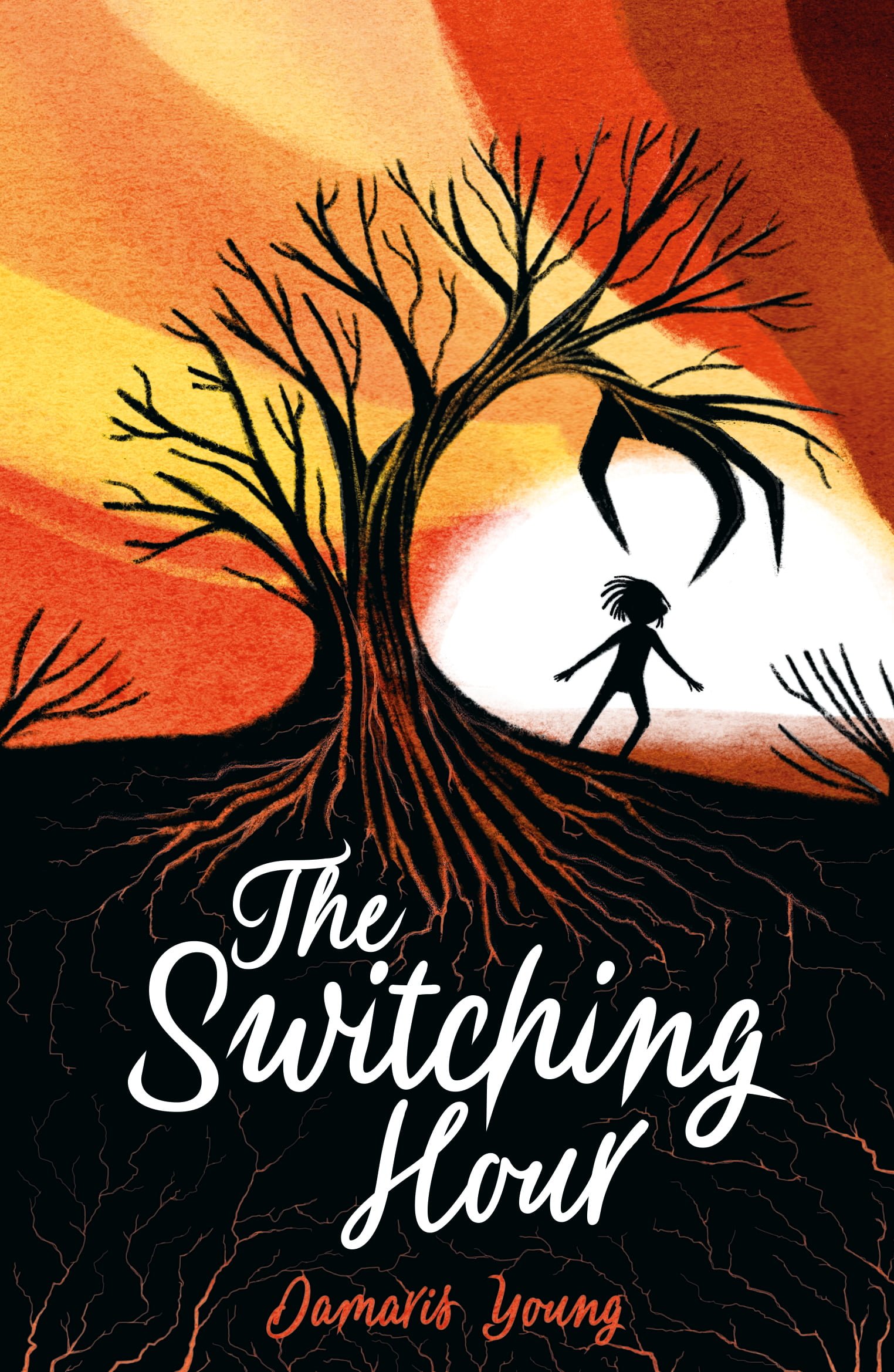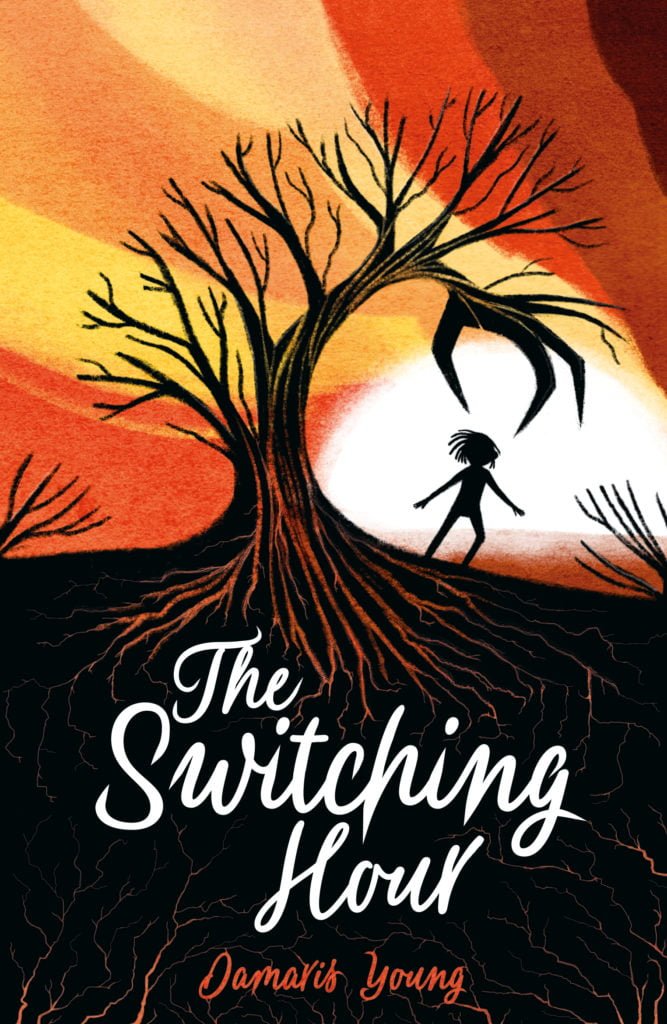Sarah Farrell talks to Damaris Young about her stunning debut, The Switching Hour. The book highlights the importance of passing on story telling traditions and the need for tackling climate change. In this bewitchingly beautiful story, Damaris Young offers a spine-tingling spooky story, with characters to believe in and cheer for.

Without giving too much away, can you tell us a bit about The Switching Hour?
The Switching Hour is about a young girl called Amaya, who lives with her grandmother, her small brother Kaleb and her pet goat in a land suffering a terrible drought.
Every night, the doors must be locked after twilight, the Switching Hour, because the drought has awoken Badeko, a creature that snatches people away to eat their dreams.
Three days later, the memory that they existed is gone from those that knew them, and those that are left are afflicted with The Sorrow Sickness – a grief which consumes a person without them knowing why.
When Kaleb is taken by Badeko, Amaya must journey into the terrifying forest to find her brother before she forgets him!
In the book, the story of Badeko is passed down through generations. How important do you think oral storytelling is in today’s world?
Stories were passed down word-of-mouth, long before paper and pen existed. Throughout the world, there is evidence of fables and folklore that tells the history of a culture, a town or a community. These stories were a way of preserving the past for future generations. In the modern world, reading about these global oral traditions can help children feel more connected to other cultures, demonstrating that you’ll find similar tales of monsters and bogeymen all around the globe. The legend of Badeko in The Switching Hour is a warning to future generations of a terrible drought, reinforces the importance of storytelling.
Can you describe Amaya in three words?
Determined, inquisitive, kind.
Amaya has a very close relationship with her grandmother and her brother, and quickly forms a strong friendship with Mally. Did you draw on any inspiration from your own life for these relationships?
My family and I are a very tight-knit group (I’m the eldest of five siblings) and incredibly supportive of each other as we continue to grow older and forge individual paths. I remember most vividly my youngest brother as a toddler, who is ten years younger than me. The overwhelming wish to protect him at all costs was something I drew on for the fictional brother, Kaleb, in The Switching Hour. Although my brother is an adult now and very tall and wise, he will always be my small brother! It is these family friendships that I have been lucky enough to experience in my life that inspired the close relationships in The Switching Hour.

The book focuses mainly on several strong female characters who stop at nothing to retrieve their loved ones and destroy the Bodeko. How important is it for you to have strong female characters in books that you read and write?
I think the idea of a strong character, male or female, is one that also shows weakness. I hope that Amaya shows readers that it is ok to be frightened sometimes, it doesn’t mean you are any less brave or courageous. Doing what you know is right, despite your fears, is what makes people brave and strong.
There is a strong theme of loss in the book, with Amaya being scared to forget both her mother and her brother. Was this difficult to write?
I think that grief is often the fear of forgetting those you love, as well as the fear of being forgotten. Due to travelling and living in lots of different places when I was younger (my parents have never been keen on settling in one place!) I have always had a fear of forgetting friends I had made and places that had been special to me. This fear intensified when I moved to the UK and I became fearful of forgetting my childhood, as memories faded and I had no shared past experiences with friends to reminiscence with. In a lot of ways, it felt like a loss of identity. Writing about loss in The Switching Hour, through the death of a loved one and the loss of another, was cathartic. It made me realise the significance of letting go of those fears; you can try to somehow lock your memories away for safekeeping or you can allow the memories to become a part of who you are.
I love the idea of Badeko being awoken by droughts. Where did the inspiration for Badeko come from?
The fact that Badeko is awoken by a terrible drought was inspired by my interest in climate issues. The dream-eating creature is a representation of our changing climate, the threat of which will ultimately hurt the younger generation the most. In The Switching Hour, the creature feeds of the dreams of the children and it is up to them to fight the Badeko, much like the children of today are campaigning against climate change. Linking an extreme weather phenomenon into the story was my way of exploring climate issues.
I really like the feel of traditional storytelling that The Switching Hour has, particularly with the legend of The Badeko being passed down through families. Can you recommend any other books which are based around myths or legends from other cultures?
There are lots of fantastic books that weave fantasy with real-world myths and legends from around the globe and these are some of my favourites;
‘The Jumbies’ by Tracey Baptiste, a spooky story of courage and adventure that draws on Caribbean folk traditions. ‘Akata Witch’ by Nnedi Okorafor, whose brilliant fantasy series weaves together Nigerian mythology and magic. ‘Water Stories from Around the World’ edited by Radhika Menon and Sandhya Rao, with beautiful illustrations by Nirupama Sekhar. This collection of retold myths and legends explores the need to value water and protect our natural world. ‘The House with Chicken Legs’ by the immensely talented Sophie Anderson, is a retelling of Baba Yaga, an age-old Russian Folklore. ‘Half World’ by Hiromi Goto. This intriguing story blends Japanese and Chinese mythologies and centres around a girl called Melanie Tamaki, who must travel to Half World, a Limbo between our world and the afterlife, when her mother disappears.
This slideshow requires JavaScript.
The setting of The Switching Hour is kept fairly ambiguous. Would you say it is largely based on a real place, or in a land of your own creation?
I drew inspiration from the landscapes that I remember as a child, growing up in Central and Southern Africa, but I also wanted to create a world that was my very own. I’ve always loved fantasy worlds, where anything and everything seems possible. I wanted to craft a new world for readers to discover!
I really like the loyalty shown by Tau, the goat who acts like a dog. What do you feel this character brings to the story? What is your favourite animal?
Tau the goat is based on my own dog, Jack, who has been my companion for over ten years. He is funny and bossy, loving and loyal. As far as goats go, a recent study showed that goats are as smart and loving as dogs, capable of building emotional relationships with humans, so it was no big stretch to model Tau after Jack! I’m a huge believer in the therapeutic powers of animal companionship and as a child my pets taught me to love and care for all creatures. I feel that Tau as a character brings to life this special connection between child and animal and hopefully fosters an appreciation for all creatures.
I would have to say my favourite animal is the loyal and wonderful dog! Their capacity to love, even after hardship is remarkable, as seen in our rescue dog, Daisy. She was immensely fearful when we brought her home but has blossomed ever since, showering us with love and affection every day.
What message would you most like readers to take away after reading The Switching Hour?
That your actions and voice do matter. I want readers to feel empowered and hopeful. The world is often a scary place, with climate change taking centre stage. Battling imaginary monsters that live between the pages of a book can do wonders for your soul.
The Switching Hour is your debut novel, and a fantastic one at that! What’s next for you?
Thank you! I’m currently writing my second standalone MG book, one that I’m also really excited about. The story follows a young girl as she fights to save a menagerie of extraordinary creatures from captivity. It deals with habitat loss and the importance of wild spaces and I can’t wait to send it out into the world.


